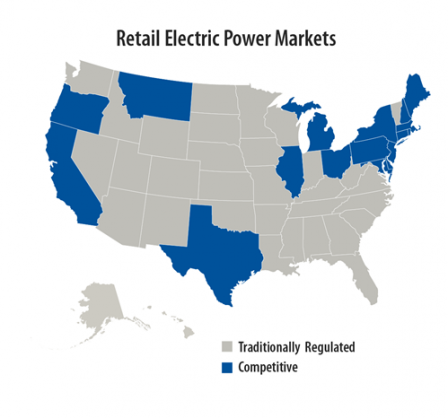Understanding Electricity Market Frameworks & Policies
Electric utilities in the United States operate under a variety of market structures, depending upon the states in which they operate.
Some states allow market competition for retail energy supply to electricity customers. This trend is called deregulation or restructuring. Utilities in deregulated markets are prohibited from generation and transmission ownership and are only responsible for distribution, operations, maintenance from the point of grid interconnection to the meter, and billing ratepayers.
 On the other hand, regulated markets feature vertically integrated utilities that own or control the total flow of electricity from generation to meter.
On the other hand, regulated markets feature vertically integrated utilities that own or control the total flow of electricity from generation to meter.
A working understanding of the utility issues in regulated and deregulated state-specific markets allows solar project developers to optimize their energy procurement strategy, anticipate their utility’s concerns, and design projects that emphasize mutual benefits. It is also important to be aware of the specific policies that impact solar development in the state in which you operate.
Below are resources to help you understand market frameworks and how they may impact your project development.
The following links exit the site Exit
- Understanding Differences in Utility Views Toward Solar (PDF) (5 pp, 287K)
- This report, developed by the U.S. Department of Energy Solar Market Pathways program, breaks down the key differences among investor-owned utilities, public and municipal utilities, and electric cooperatives. These differences in ownership shape how a utility sets the rates that it charges to customers, and this, in turn, determines the financial impact on the solar generation project. The report also discusses considerations for the different market structures under which electric utilities in the United States operate.
- Database of State Incentives for Renewables & Efficiency (DSIRE)
- DSIRE, operated by the N.C. Clean Energy Technology Center, is the most comprehensive source of information on incentives and policies that support renewable energy and energy efficiency programs in the United States. This tool is used as an informational resource to define various federal, state, local, and utility policies, and to describe how and where these polices are structured and implemented. DSIRE provides specific information on policies that directly impact solar development in your state.
- The Impacts of Commercial Electric Utility Rate Structure Elements on the Economics of Photovoltaic Systems (PDF) (30 pp, 568K)
- Compensation for commercial net-metered PV systems is dictated primarily by the utility rate structure under which the solar PV system operates. Electric utility tariffs across the United States consist of many different rate components, all of which have an impact on PV system economics. This report, produced by the National Renewable Energy Laboratory in 2010, identifies the effects of rate structures on system economics, which can help project developers make informed choices in order to maximize their return on investment.
- Decoupling Utility Profits from Sales: Issues for the Photovoltaic Industry (PDF) (31 pp, 777K)
- Investor-owned electric utilities are typical businesses in many respects. Increased electricity sales mean increased revenues and, by association, profits. As a result, utilities have a strong incentive to increase sales and limit activities that reduce sales. This simple relationship captures what is typically called the utility’s “throughput incentive,” which can work against competing public policies that support energy efficiency and distributed resources.

